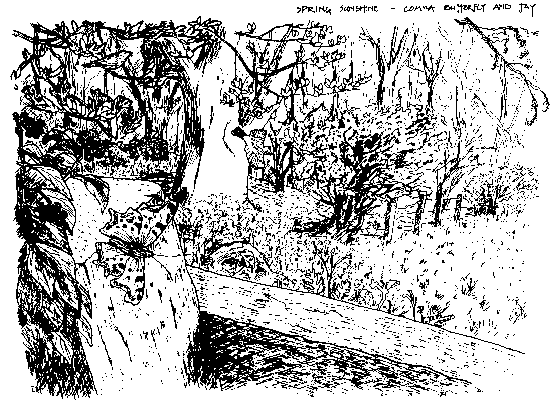
| Home | Credits | Woodland | History | The Year Round | Species | Bibliography | Maps |
Exploring Worcester Woods
Nick Cripps


| Home | Credits | Woodland | History | The Year Round | Species | Bibliography | Maps |

Ground Ivy is a small native perennial which prefers the sunny wood edge. It displays fan-like leaves and lilac-blue trumpet flowers. The Common Dog-violet grows on the sunnier bank of Nunnery pond and individually along the woodland paths. The attractive petals of the violet vary in colour, but sadly remain unscented.
The straggly plant, Greater Stitchwort is common to all four woods. It’s fresh-white, deeply-cut petals are very attractive despite its peculiar nickname, Adder's Meat! Goldilocks prefers the damp conditions near Nunnery Pond. It is a member of the buttercup family, and often its butter-yellow petals are of unequal size.
Many flowers of the woodland edge are also found in roadside hedgerows. Plants such as Red Deadnettle, Garlic Mustard and Cow Parsley - often nickname Queen Anne's Lace - are all in abundance.
In amongst the damper grassland, particularly Perry Wood meadow, is found Ladies Smock or Cuckoo Flower. The ladies smock has delicate, pale-lilac petals, and is one of the food plants for the larvae of the orange tip butterfly.
Come month-end, the Whitethroat and its skulking cousin, the Lesser Whitethroat, take up residence in the scrubby areas and along the taller hedgerows. Wood Warbler and Nightingale also occasionally visit.
Virtually all our resident birds lay their eggs during April. A few, notably Blackbird and Mistle Thrush, will have youngsters outside the nest before month-end. Now they must survive the predations of magpies, jays, crows, rats, squirrels, and weasels, all of whom are common chick-thieves. So please report any nest locations to the rangers so that steps can be taken to safeguard them.

The Park uses traditional woodland methods of coppice rotation, tree thinning, wood edge bramble and grassy margins to help maintain habitats for woodland and grassland butterflies, as well as locally rare species and infrequent migrant visitors.
During spring’s warm, sunny days the butterflies that overwintered as adults emerge. Flying high are the longest-lived of our British butterflies, the conspicuous Brimstone, with its unique pointed wings. The brimstone was known to early lepidopterists as the 'butter-coloured fly' a name that easily shortened to butterfly!
Three other butterflies to look out for are: the colourful Small Tortoiseshell; the Comma, with its heavily indented wing edges; and the large, distinctive Peacock, with its exotic 'eye' spots on the forewing.
Any blue butterfly on the wing before May is almost certain to be the diminutive Holly Blue. The holly blue has its own territory, often flying high amongst holly trees. It is the only species to change its food plant seasonally: the eggs for the first brood being laid on holly, and on ivy for the second brood.
The Small White, Green Veined White and Speckled Wood butterflies can all be expected to hatch before May. The Speckled Wood enjoys dappled sunlight and can be found inside the wood and along the wood edge until October.
As imagined from its name the Stinkhorn mushroom is renowned for its unmis-takeable shape and ghastly smell. Often the fungus, standing a good 20cm high, is surrounded by excited flies. The Shaggy Ink Cap, also called Lawyers Wig, is a large conical mushroom, often found both in the woods and on grassland.

Worcester Woods Title Page
Worcestershire History Encyclopaedia